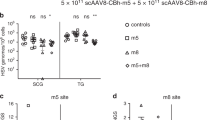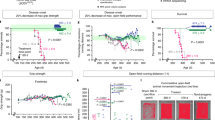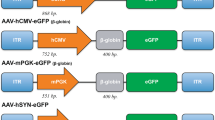Abstract
The use of viral vectors for gene delivery to motor neurons in vivo has been hampered by the need to perform invasive surgery to inject directly the vector into the anterior horn of the spinal cord. Here, we have characterized the features of herpes simplex virus-1 (HSV)-derived vectors, in terms of gene mutations and promoter constructs, that are required to allow efficient transduction of motor neurons following a relatively noninvasive peripheral administration via sciatic nerve or footpad injection. Owing to the wide variety of animal models used to study neurodegenerative diseases of motor neurons, we analysed the effectiveness of these vectors in adult mice and adult and neonatal rats. We tested viruses with differing degrees of disablement based on the 1764 backbone (deleted for ICP34.5 and an insertional inactivation in VP16) rendered completely replication incompetent by the deletion of the essential immediate-early genes ICP27 and/or ICP4. In the adult mouse, prolonged gene expression in motor neurons was obtained after sciatic nerve inoculation with a vector defective in ICP4 and ICP27. In the adult rat, both the vector defective in ICP4 and the vector defective in ICP4 and ICP27 were capable of transducing motor neurons for extended periods of time during viral latency. This study demonstrates the feasibility of using HSV vectors for persistent transgene expression in motor neurons in a safe and nontoxic manner following peripheral administration. These vectors are potentially useful tools to investigate the functions of genes involved in motor neuronal survival and regeneration in models of motor neuron diseases in vivo.
This is a preview of subscription content, access via your institution
Access options
Subscribe to this journal
Receive 12 print issues and online access
$259.00 per year
only $21.58 per issue
Buy this article
- Purchase on Springer Link
- Instant access to full article PDF
Prices may be subject to local taxes which are calculated during checkout









Similar content being viewed by others
References
Jackson CE, Bryan WW . Amyotrophic lateral sclerosis. Semin Neurol 1998; 18: 27–39.
Yan Q, Elliott J, Snider WD . Brain-derived neurotrophic factor rescues spinal motor neurons from axotomy-induced cell death. Nature 1992; 360: 753–755.
Henderson CE et al. Neurotrophins promote motor neuron survival and are present in embryonic limb bud. Nature 1993; 363: 266–270.
Sendtner M et al. Ciliary neurotrophic factor prevents degeneration of motor neurons in mouse mutant progressive motor neuronopathy. Nature 1992; 358: 502–504.
Sendtner M et al. Brain-derived neurotrophic factor prevents the death of motoneurons in newborn rats after nerve section. Nature 1992; 360: 757–759.
Pennica D et al. Cardiotrophin-1, a cytokine present in embryonic muscle, supports long-term survival of spinal motoneurons. Neuron 1996; 17: 63–74.
Livesey FJ et al. A Schwann cell mitogen accompanying regeneration of motor neurons. Nature 1997; 390: 614–618.
Sendtner M, Kreutzberg GW, Thoenen H . Ciliary neurotrophic factor prevents the degeneration of motor neurons after axotomy. Nature 1990; 345: 440–441.
Dittrich F et al. Pharmacokinetics of intrathecally applied BDNF and effects on spinal motoneurons. Exp Neurol 1996; 141: 225–239.
Miller RG et al. A placebo-controlled trial of recombinant human ciliary neurotrophic (rhCNTF) factor in amyotrophic lateral sclerosis. rhCNTF ALS Study Group. Ann Neurol 1996; 39: 256–260.
Cisterni C et al. Efficient gene transfer and expression of biologically active glial cell line-derived neurotrophic factor in rat motoneurons transduced with lentiviral vectors. J Neurochem 2000; 74: 1820–1828.
Tang XQ, Wang Y, Han JS, Wan Y . Adenovirus-mediated GDNF protects cultured motoneurons from glutamate injury. Neuroreport 2001; 12: 3073–3076.
Lisovoski F et al. In vivo transfer of a marker gene to study motoneuronal development. Neuroreport 1994; 5: 1069–1072.
Hermens WT et al. Purification of recombinant adeno-associated virus by iodixanol gradient ultracentrifugation allows rapid and reproducible preparation of vector stocks for gene transfer in the nervous system. Hum Gene Ther 1999; 10: 1885–1891.
Wang LJ et al. Neuroprotective effects of glial cell line-derived neurotrophic factor mediated by an adeno-associated virus vector in a transgenic animal model of amyotrophic lateral sclerosis. J Neurosci 2002; 22: 6920–6928.
Azzouz M et al. Increased motoneuron survival and improved neuromuscular function in transgenic ALS mice after intraspinal injection of an adeno-associated virus encoding Bcl-2. Hum Mol Genet 2000; 9: 803–811.
Hottinger AF et al. Complete and long-term rescue of lesioned adult motoneurons by lentiviral-mediated expression of glial cell line-derived neurotrophic factor in the facial nucleus. J Neurosci 2000; 20: 5587–5593.
Bledsoe AW, Jackson CA, McPherson S, Morrow CD . Cytokine production in motor neurons by poliovirus replicon vector gene delivery. Nat Biotechnol 2000; 18: 964–969.
Yamada M et al. Herpes simplex virus vector-mediated expression of Bcl-2 protects spinal motor neurons from degeneration following root avulsion. Exp Neurol 2001; 168: 225–230.
Natsume A et al. Bcl-2 and GDNF delivered by HSV-mediated gene transfer after spinal root avulsion provide a synergistic effect. J Neurotrauma 2002; 19: 61–68.
Lilley CE et al. Multiple immediate-early gene-deficient herpes simplex virus vectors allowing efficient gene delivery to neurons in culture and widespread gene delivery to the central nervous system in vivo. J Virol 2001; 75: 4343–4356.
Kaspar BK et al. Targeted retrograde gene delivery for neuronal protection. Mol Ther 2002; 5: 50–56.
Boulis NM et al. Intraneural colchicine inhibition of adenoviral and adeno-associated viral vector remote spinal cord gene delivery. Neurosurgery 2003; 52: 381–387; discussion 387.
Davidson BL et al. Recombinant adeno-associated virus type 2, 4, and 5 vectors: transduction of variant cell types and regions in the mammalian central nervous system. Proc Natl Acad Sci USA 2000; 97: 3428–3432.
Kaspar BK et al. Retrograde viral delivery of IGF-1 prolongs survival in a mouse ALS model. Science 2003; 301: 839–842.
Haase G et al. Gene therapy of murine motor neuron disease using adenoviral vectors for neurotrophic factors. Nat Med 1997; 3: 429–436.
Haase G et al. Adenovirus-mediated transfer of the neurotrophin-3 gene into skeletal muscle of pmn mice: therapeutic effects and mechanisms of action. J Neurol Sci 1998; 160: S97–S105.
Bordet T et al. Protective effects of cardiotrophin-1 adenoviral gene transfer on neuromuscular degeneration in transgenic ALS mice. Hum Mol Genet 2001; 10: 1925–1933.
Palmer JA et al. Development and optimization of herpes simplex virus vectors for multiple long-term gene delivery to the peripheral nervous system. J Virol 2000; 74: 5604–5618.
Goins WF et al. A novel latency-active promoter is contained within the herpes simplex virus type 1 UL flanking repeats. J Virol 1994; 68: 2239–2252.
Neve RL, Howe JR, Hong S, Kalb RG . Introduction of the glutamate receptor subunit 1 into motor neurons in vitro and in vivo using a recombinant herpes simplex virus. Neuroscience 1997; 79: 435–447.
Yamamura J et al. Long-term gene expression in the anterior horn motor neurons after intramuscular inoculation of a live herpes simplex virus vector. Gene Therapy 2000; 7: 934–941.
Keir SD, Mitchell WJ, Feldman LT, Martin JR . Targeting and gene expression in spinal cord motor neurons following intramuscular inoculation of an HSV-1 vector. J Neurovirol 1995; 1: 259–267.
Dobson AT et al. A latent, nonpathogenic HSV-1-derived vector stably expresses beta-galactosidase in mouse neurons. Neuron 1990; 5: 353–360.
Wharton SB, Meyers NL, Nash AA . Experimental herpes simplex virus type 1 (HSV-1) infection of the spinal cord and dorsal root ganglia. Neuropathol Appl Neurobiol 1995; 21: 228–237.
Snider WD, Elliott JL, Yan Q . Axotomy-induced neuronal death during development. J Neurobiol 1992; 23: 1231–1246.
Marshall KR et al. Long-term transgene expression in mice infected with a herpes simplex virus type 1 mutant severely impaired for immediate-early gene expression. J Virol 2000; 74: 956–964.
Lillycrop KA et al. The octamer-binding protein Oct-2 represses HSV immediate-early genes in cell lines derived from latently infectable sensory neurons. Neuron 1991; 7: 381–390.
Lokensgard JR, Bloom DC, Dobson AT, Feldman LT . Long-term promoter activity during herpes simplex virus latency. J Virol 1994; 68: 7148–7158.
McMenamin MM et al. A gamma34.5 mutant of herpes simplex 1 causes severe inflammation in the brain. Neuroscience 1998; 83: 1225–1237.
Simmons A, Tscharke D, Speck P . The role of immune mechanisms in control of herpes simplex virus infection of the peripheral nervous system. Curr Top Microbiol Immunol 1992; 179: 31–56.
Goss JR et al. Antinociceptive effect of a genomic herpes simplex virus-based vector expressing human proenkephalin in rat dorsal root ganglion. Gene Therapy 2001; 8: 551–556.
Chattopadhyay M et al. In vivo gene therapy for pyridoxine-induced neuropathy by herpes simplex virus-mediated gene transfer of neurotrophin-3. Ann Neurol 2002; 51: 19–27.
Gravel C, Gotz R, Lorrain A, Sendtner M . Adenoviral gene transfer of ciliary neurotrophic factor and brain-derived neurotrophic factor leads to long-term survival of axotomized motor neurons. Nat Med 1997; 3: 765–770.
Gimenez y Ribotta M et al. Prevention of motoneuron death by adenovirus-mediated neurotrophic factors. J Neurosci Res 1997; 48: 281–285.
Baumgartner BJ, Shine HD . Permanent rescue of lesioned neonatal motoneurons and enhanced axonal regeneration by adenovirus-mediated expression of glial cell-line-derived neurotrophic factor. J Neurosci Res 1998; 54: 766–777.
Coffin RS, MacLean AR, Latchman DS, Brown SM . Gene delivery to the central and peripheral nervous systems of mice using HSV1 ICP34.5 deletion mutant vectors. Gene Therapy 1996; 3: 886–891.
Brown SM, Ritchie DA, Subak-Sharpe JH . Genetic studies with herpes simplex virus type 1. The isolation of temperature-sensitive mutants, their arrangement into complementation groups and recombination analysis leading to a linkage map. J Gen Virol 1973; 18: 329–346.
MacLean AR et al. Herpes simplex virus type 1 deletion variants 1714 and 1716 pinpoint neurovirulence-related sequences in Glasgow strain 17+ between immediate early gene 1 and the ‘a’ sequence. J Gen Virol 1991; 72: 631–639.
Ace CI et al. Construction and characterization of a herpes simplex virus type 1 mutant unable to transinduce immediate-early gene expression. J Virol 1989; 63: 2260–2269.
Thomas SK, Lilley CE, Latchman DS, Coffin RS . Equine herpesvirus 1 gene 12 can substitute for vmw65 in the growth of herpes simplex virus (HSV) type 1, allowing the generation of optimized cell lines for the propagation of HSV vectors with multiple immediate-early gene defects. J Virol 1999; 73: 7399–7409.
Acknowledgements
We are grateful to the Motor Neurone Disease Association, Medical Research Council and BioVex Ltd for the support of this work.
Author information
Authors and Affiliations
Rights and permissions
About this article
Cite this article
Perez, M., Hunt, S., Coffin, R. et al. Comparative analysis of genomic HSV vectors for gene delivery to motor neurons following peripheral inoculation in vivo. Gene Ther 11, 1023–1032 (2004). https://doi.org/10.1038/sj.gt.3302258
Received:
Accepted:
Published:
Issue Date:
DOI: https://doi.org/10.1038/sj.gt.3302258
Keywords
This article is cited by
-
Recombinant Adeno-Associated Virus Serotype 6 (rAAV2/6)-Mediated Gene Transfer to Nociceptive Neurons through Different Routes of Delivery
Molecular Pain (2009)
-
Gene therapy for the treatment of diabetic neuropathy
Current Diabetes Reports (2008)
-
Transduction of Brain by Herpes Simplex Virus Vectors
Molecular Therapy (2007)



